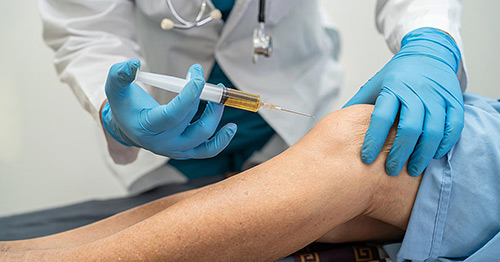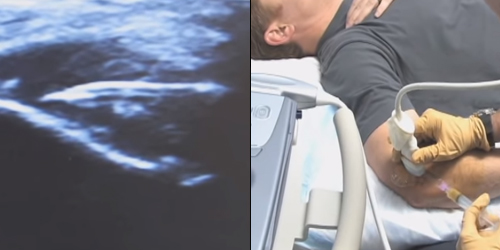Platelet-Rich Plasma (PRP) Injections
In recent years, doctors have learned that the body has the ability to heal itself.

Platelet-rich plasma therapy is a form of regenerative medicine that harnesses and amplifies the natural growth factors found in our blood cells to help heal damaged tissue.
What is plasma and what are platelets?
Plasma is the liquid portion of whole blood. It is composed largely of water and proteins, and it provides a medium for red blood cells, white blood cells and platelets to circulate through the body. Platelets, also called thrombocytes, are blood cells that cause blood clots, as well as other necessary growth and healing functions.
What is a PRP injection?
Platelet-rich plasma (PRP) is produced from a person's own blood. It is a concentration of one type of blood cell (platelets), which is critical for blood clotting. This concentration is injected to an injured or diseased part of a person’s body to accelerate the healing of damaged tendons, ligaments, muscles, bones and joints. A key advantage of PRP injections is that they can reduce the need for opioids, or even over-the-counter anti-inflammatory medications. In fact, use of anti-inflammatories should usually be ceased at the time of PRP treatment, because the platelet-rich plasma optimizes the initial inflammatory response involved with healing.
How are PRP injections performed?
PRP injections are prepared by taking anywhere from one to a few tubes of your own blood. It is then run ("spun down") in a centrifuge to separates the blood into its various components: red and white blood cells, plasma, platelets, etc. The platelets are collected and concentrated to anywhere from 2 to 8 times their normal number. The platelets are then mixed into a blood plasma liquid base and injected directly into the area of injury. Ultrasound imaging is sometimes used to guide the injection. The images below show a PRP injection into a patient's torn tendon. The ultrasound guidance is shown at left and the injection is shown at right.

How do PRP injections work?
The activation of the concentrated platelets in platelet-rich plasma releases growth factors that stimulate and increase the number of reparative cells your body produces. This significantly enhances the body's natural healing process.
Video: How platelet-rich plasma injections work – A patient experience
In this video, HSS sports medicine physician Brian D. Halpern discusses and demonstrates PRP injections.
What injuries can PRP injections treat?
PRPs injections are used primarily for soft tissue injuries, such as minor rotator cuff and Achilles tendon tears. Its use in other soft-tissue injuries is becoming more common. It has been demonstrated to improve function and reduce pain in people who have tendonitis or chronic tendinosis conditions such as tennis elbow or golfer's elbow.
It can also be used to treat injuries to ligaments and muscles. For example, improved muscle regeneration has been shown in gastrocnemius (calf) muscle injuries.
Recent data suggests that PRP treatment is superior to than hyaluronic acid injections (also known as viscosupplementation or “gel shots”) for knee osteoarthritis, especially in regard to the duration of its positive effect. However, emerging data demonstrates that PRP combined with hyaluronic acid is more effective than either treatment alone.
Do PRP injections have side effects or risks?
Side effects of PRP injections are very limited because the injections are created from your own blood, and your body should not reject them or react in any negative way. As with any injection, there is a remote risk of infection. Otherwise, there are no significant risks apart from the variability and unpredictability of how effective the treatment will be for a particular patient.
Articles related to platelet-rich plasma injections
Articles on conditions that may be treated with PRP
Learn about injuries and conditions which may be treated with platelet-rich plasma injections.
Platelet-Rich Plasma (PRP) Injections Success Stories
In the news
References
- Creighton A, Sanguino RA, Cheng J, Wyss JF. Successful Treatment of Supraspinous and Interspinous Ligament Injury With Ultrasound-Guided Platelet-Rich Plasma Injection: Case Series. HSS J. 2021 Jul;17(2):227-230. doi: 10.1177/1556331621992312. Epub 2021 Feb 22. PMID: 34421435; PMCID: PMC8361589.
- Davenport KL, Campos JS, Nguyen J, Saboeiro G, Adler RS, Moley PJ. Ultrasound-Guided Intratendinous Injections With Platelet-Rich Plasma or Autologous Whole Blood for Treatment of Proximal Hamstring Tendinopathy: A Double-Blind Randomized Controlled Trial. J Ultrasound Med. 2015 Aug;34(8):1455-63. Doi: 10.7863/ultra.34.8.1455. PMID: 26206832.
- Halpern BC, Chaudhury S, Rodeo SA. The role of platelet-rich plasma in inducing musculoskeletal tissue healing. HSS J. 2012 Jul;8(2):137-45. Doi: 10.1007/s11420-011-9239-7. Epub 2012 Jan 18. PMID: 23874254; PMCID: PMC3715623.
- Kirschner JS, Cheng J, Creighton A, Santiago K, Hurwitz N, Dundas M, Beatty N, Kingsbury D, Konin G, Abutalib Z, Chang R. Efficacy of Ultrasound-Guided Glenohumeral Joint Injections of Leukocyte-Poor Platelet-Rich Plasma Versus Hyaluronic Acid in the Treatment of Glenohumeral Osteoarthritis: A Randomized, Double-Blind Controlled Trial. Clin J Sport Med. 2022 Nov 1;32(6):558-566. doi: 10.1097/JSM.0000000000001029. Epub 2022 Mar 17. PMID: 35316820; PMCID: PMC9481749.
- Magruder ML, Caughey S, Gordon AM, Capotosto B S S, Rodeo SA. Trends in utilization, demographics, and costs of platelet-rich plasma injections: a ten-year nationwide investigation. Phys Sportsmed. 2023 Feb 17:1-9. doi: 10.1080/00913847.2023.2178816. Epub ahead of print. PMID: 36755520.Taylor SA, Hannafin JA. Evaluation and management of elbow tendinopathy. Sports Health. 2012 Sep;4(5):384-93. doi: 10.1177/1941738112454651. PMID: 23016111; PMCID: PMC3435941.
- Rodeo SA. Orthobiologics: Current Status in 2023 and Future Outlook. J Am Acad Orthop Surg. 2023 Jun 15;31(12):604-613. doi: 10.5435/JAAOS-D-22-00808. Epub 2023 May 1. PMID: 37130369.
- Wang D, Rodeo SA. Platelet-Rich Plasma in Orthopaedic Surgery: A Critical Analysis Review. JBJS Rev. 2017 Sep;5(9):e7. doi: 10.2106/JBJS.RVW.17.00024. PMID: 28953136.
- Williams PN, Moran G, Bradley JP, S ElAttrache N, Dines JS. Platelet-rich plasma and other cellular strategies in orthopedic surgery. Curr Rev Musculoskelet Med. 2015 Mar;8(1):32-39. doi: 10.1007/s12178-014-9246-7. Erratum in: Curr Rev Musculoskelet Med. 2017 Jul 15;: PMID: 25576070; PMCID: PMC4596183.
- Zahir H, Dehghani B, Yuan X, Chinenov Y, Kim C, Burge A, Bandhari R, Nemirov D, Fava P, Moley P, Potter H, Nguyen J, Halpern B, Donlin L, Ivashkiv L, Rodeo S, Otero M. In vitro responses to platelet-rich-plasma are associated with variable clinical outcomes in patients with knee osteoarthritis. Sci Rep. 2021 Jun 1;11(1):11493. doi: 10.1038/s41598-021-90174-x. PMID: 34075069; PMCID: PMC8169703.
Updated: 11/1/2023
Reviewed and updated by Scott Rodeo, MD